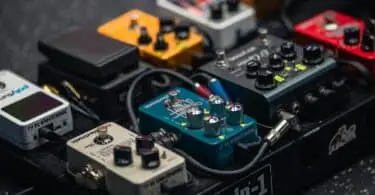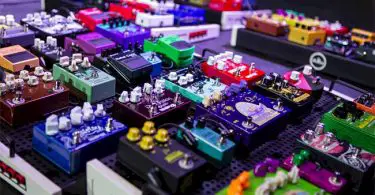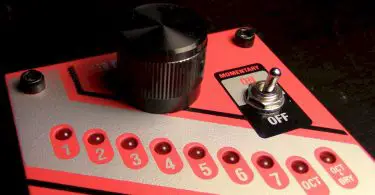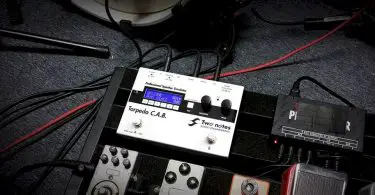Professional musicians usually have professional gear. Although cheap stuff has been used to great effect, professional gear usually means expensive stuff — which can be a problem if you’re trying to replicate the tone of a particular musician and are on a budget.
Besides high-end guitars and amplifiers, the pedals most musicians use are also costly. Luckily, if you can’t afford a series of $200 pedals, there are budget alternatives that, while having its limitations, sound reasonably good.
In this article, I’m going to review some budget pedals that will increase your tonal possibilities without breaking the bank.
Behringer4 is a well-known German company which produces musical equipment. Most of their pedals aren’t very high-end and do sometimes seem a little lackluster, but there are some real gems hidden in the company’s lineup.
Behringer pedals are cheap and reliable — and sometimes very good as well. Don’t believe me? Then let’s take a look at these Behringer pedals.
When you buy through links on our site, we may earn an affiliate commission. As an Amazon Associate I earn from qualifying purchases.
Quick Links
Best Behringer Pedals — Comparison Table
- BEHRINGER 10 String Vintage Monster VT999 Classic Vacuum Tube Overdrive, Ambidextrous, Gld/Blk
- Very versatile
- Sounds like a Marshall amplifier
- Changeable tube
- Behringer DR600 DIGITAL REVERB Digital Stereo Reverb Effects Pedal
- Good tonal range
- Different reverb styles
- Very affordable
- BEHRINGER EQ Effects Pedal, Gray (FX600)
- Multiple effects in a single pedal
- Budget-friendly
- BEHRINGER VP1 Authentic Vintage-Style Phase Shifter Black and Silver, Slvr/Blk (VP1/B)
- Excellent phaser
- Rate control knob
- Great vintage sound

➡ Integrated switchable noise gate
➡ 3-band EQ
➡ Dedicated gain and master controls

➡ 24-bit high-resolution stereo reverbs
➡ Dedicated mode
➡ Time, tone, and level controls

➡ Powered by 9V battery or DC power supply
➡ High-resolution stereo effects
➡ Status LED for battery check

➡ Three-dimensional phase shifting
➡ Dedicated rate control
➡ True bypass
Best Behringer Pedals Review
1. Behringer Vintage Tube Monster VT999
- Very versatile
- Sounds like a Marshall amplifier
- Changeable tube
➡ Integrated switchable noise gate
➡ 3-band EQ
➡ Dedicated gain and master controls
The Vintage Tube Monster VT999 should probably be illegal. It’s too much pedal for such a low price. You would think that with this money, you’d be buying something to play around with once or twice and never look at again, but instead, you’ll find that this Behringer pedal could very well be a permanent addition to your gigging equipment.
Straight out of the box, you notice that this pedal has what feels like a premium build. The all-metal case is heavy and makes this enormous pedal looks way more expensive than it is.
There are plenty of tonal possibilities with this pedal. Its tone is always going to be in the vintage high-gain Marshall amplifier range, but there are plenty of options within that framework.
This pedal really shines with heavy metal-type tones, but it’s also versatile enough to allow for calmer styles, such as blues and classic rock. Regardless of the genre, you’re playing, this pedal is always going to bring you an excellent, punchy tone.
Since this is a tube pedal, you can easily switch out its tube to considerably change its tone. The tube is come with is very good, but it never hurts to have the possibility of improving on what is already a great pedal.
Can you use this pedal with a harmonica?
Yes. You can use this pedal with any instrument, assuming it has the proper wiring.
Can you switch out the included tube?
Yes, you can. The included tube is easily replaceable.
Does this pedal come with a power supply?
Yes, this pedal comes with the power supply.
Who this is for?
Someone looking for a versatile, Marshall-like pedal on a budget.
Why I like it?
This pedal shouldn’t exist — it’s way too good for its price.
2. Behringer DR600
- Good tonal range
- Different reverb styles
- Very affordable
➡ 24-bit high-resolution stereo reverbs
➡ Dedicated mode
➡ Time, tone, and level controls
The DR600 is an inexpensive reverb pedal that works just as you would expect. Let’s not fool ourselves — this is not a great reverb pedal. For the price, however, it’s as good as you’re going to get.
The build quality of this pedal isn’t very good, but that’s the case with most Behringer pedals that have this format. They don’t seem very durable, but, unless something extreme happens, they’re probably going to work just fine for a long time.
There’s a considerable amount of reverb tonal range, and you can customize the output with the time setting. The mode knob controls the reverb type and offers a different reverb experience in each position.
The sound quality isn’t stellar. It’s acceptable, but probably not something you’d like to use on an actual gig. For practice at home, however, it works great.
Does the power supply come included?
No. You can use any 9V power adapter with this pedal.
Will this pedal work with a bass guitar?
Yes. This pedal will work with any instrument as long as you can plug it in.
Who this is for?
Someone looking for an inexpensive reverb pedal.
Why I like it?
The DR600 brings acceptable enough reverb at an affordable price.
3. Behringer Digital Multi-FX FX600
- Multiple effects in a single pedal
- Budget-friendly
➡ Powered by 9V battery or DC power supply
➡ High-resolution stereo effects
➡ Status LED for battery check
The Behringer Digital Multi-FX FX600 has five different effects, which you can slightly alter for different tonalities. They’re not as good as the same effects would be on a dedicated pedal or a more expensive pedal, but for the price, they’re outstanding.
With this pedal, you can choose between a flanger, chorus, phaser, delay, or tremolo effect. Unfortunately, you can’t use more than one effect simultaneously, which might not be that bad — all of these effects have strong similarities and would perhaps become too muddled if combined.
The effects aren’t crystal clear, and the sound quality could be better. However, there aren’t many cheap alternatives that combine all of these effects in a single package. If you want to try these effects and maybe later down the road, buy a dedicated pedal, then the FX600 is an affordable pedal, to begin with.
Can you use more than one effect at the same time?
No. Each effect is controlled by the same knob, meaning you can only have one activated at a time.
Is there an echo effect on this pedal?
No, however, there is a tremolo and a delay effect.
Who this is for?
Someone who wants to try several effects and doesn’t mind about their quality.
Why I like it?
There aren’t many pedals that combine these many effects for such a low price.
4. Behringer Ultra Metal UM300
This pedal is ideal for players who want to play metal but lack the budget for the more premium pedals. But you shouldn’t be fooled by its price — the UM3005 packs quite the punch regardless of its price tag.
Mids control whether the sound has any aggressive definition or ends up just sounding muddled. That’s why this pedal forgoes a regular 3-band EQ for one with more mid control. One knob controls the mids while other controls its frequency, which allows you to regulate just how aggressive your sound.
Although the distortion sounds good at the middle, when you crank it all the way up, the sound ends up losing its definition. You can definitely play metal with this pedal, as long as you don’t push it too far. Still, it’s an excellent buy for the price.
Is this pedal mono or stereo?
This pedal has a mono connection.
Does this pedal come with the power adapter?
No. You will need a separate power supply.
Who this is for?
Someone who plays metal and is on a budget.
Why I like it?
The distortion sounds great at medium levels.
5. Behringer Vintage Phaser VP1
- Excellent phaser
- Rate control knob
- Great vintage sound
➡ Three-dimensional phase shifting
➡ Dedicated rate control
➡ True bypass
Pedals that dedicate themselves to a single function are usually better than the ones who try to have all the effects at once. The VP1 is a dedicated phaser, and that’s it. There’s just a single rate-setting knob in the middle and a small tone-setting button next to it.
There are no other functions nor knobs to fiddle around with. It’s a phaser and a really good one for the price.
This pedal has a distinctive vintage tone that makes it able to compete with the more expensive phasers. Not everyone is going to prefer it over an MXR phaser, but some players definitely will — and don’t forget that this pedal is way cheaper than the MXR.
If you’re looking for a phaser and are on a budget, don’t think twice. Just get this pedal.
Does this pedal also have a distortion effect?
No, this pedal only has a phase effect.
Is this pedal similar to the MXR Phase 90 or 100?
No. This pedal is similar to a 70s single-knob phaser.
Who this is for
Someone looking for an affordable phaser.
Why I like it
It’s a phaser (and a very good one), and that’s it.
Wrapping Up
You don’t have to spend a lot of money to be able to have fun with pedals. The pedals on this list might not win any prizes and even seem a little lackluster when compared to the more expensive ones, but they have excellent quality for their price.
Of course, that’s not the case with every single pedal on this list. The Behringer Vintage Tube Monster VT999 is quite capable of competing with the more expensive pedals. This tube pedal shouldn’t sound as good as it does when you consider its price, but it does, and that’s great for us.
You can always upgrade to a better pedal once you have fun with these and decide exactly what it is that you want in a pedal. Until then, the Behringer pedals will enhance your playing experience.
Behringer PB1000 Universal Effects Pedal Floor Board with Integrated Power Supply — Buyer’s Guide
- Price
- Patch cable included in delivery
➡ Up to 12 pedals
➡ 9 Volt DC 1700 mA
➡ 66 x12 x 48 mm ( W x H x D )
When it comes to electronic equipment for musicians, there is hardly any area in which the name Behringer is not represented. Tuners, floor effects, amplifiers of all kinds, audio interfaces, 19″ studio equipment, or just about any other piece of equipment – Behringer has them all. All products have one thing in common: they are in the lower price segment and are affordable even for the small purse. And we guitarists don’t miss out either, which can be seen, for example, in the countless floorboards.
Behringer offers two pedalboards, the PB600 and PB1000, with the former providing shelter for up to 6, the latter up to 12 pedal mines. Since the number of effects that can be integrated refers to Boss dimensions, the two pedalboards differ only in their outer dimensions, so the PB1000 is about twice as big as its little brother. For the sake of simplicity, we have dedicated this review to the PB1000.
Review
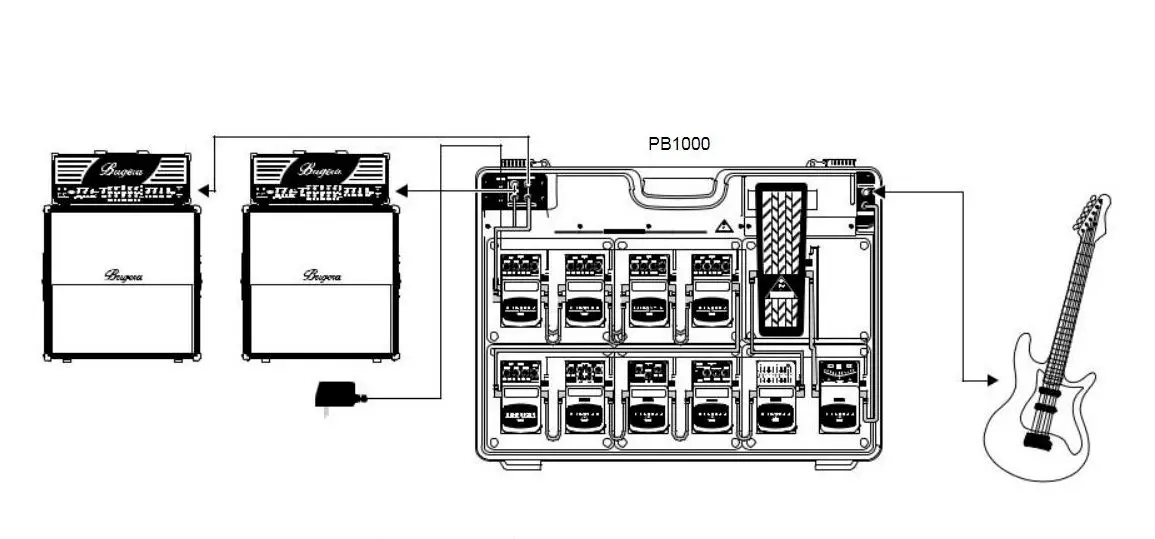
Behringer PB1000 Pedal Board Setup Guide
The PB1000 from Behringer is a board designed for guitar pedal effects. The fact that you can integrate 12 of them sounds like a lot. These are pedals of the size that Boss has made into a quasi-standard. And that also corresponds to those from Behringer. If larger pedals are used, such as the legendary devices from Electro Harmonix or boutique parts from Analogman or Baldringer, this limits the number somewhat. But just between us: Who needs 12-floor pedals? Well, I’ll start with the live situation. If you want to use 12 pedals without a looper here, you’ll quickly go crazy. Switching from a dry clean sound to an effect-loaded high-gain lead sound with delay quickly turns into a time-consuming tap dance.
Another problem when cascading so many floor pedals is the loss of dynamics. The guitar signal is relatively weak and naturally very susceptible to interference. If the pedals are not equipped with a true bypass, the signal always passes through the entire electronics of the devices, which does not necessarily meet the “good tone”.
The case in case form consists of two parts, the bottom on which the pedals are mounted and the removable cover. The lid is hung in half-open hinges at the back and fixed at the front with sliding plastic catches, which are a bit stiff and complicate the process the first time. After some practice, however, the assembly works smoothly. To keep the pedals in position during transport, the lid is lined with nubby foam. So the bottom effects are pressed into the pre-cut recesses when closing. If you want to accommodate pedal leads from other manufacturers than Boss or Behringer, you can unscrew some of the rigid foam elements. Two effects share one of each, which is held by four screws. Afterward, even large pedals fit – great idea! I would then fix them with Velcro tape, which can be removed entirely later.
In the front area of the pedalboard, there are two sockets. In one of them, the power supply is plugged in, and in the other one, the cable whip is plugged in, which supplies all effect units with power. The PB1000 comes with a separate 9 Volt power supply with 1700 mA — a flexible solution, especially for transport. So the separate power supply can be removed and safely stored after the gig, the distribution cable remains connected to the pedals. Since the units are connected to a single cable, this can lead to hum loops in one case or another. It will be criminal in any case with old fuzz pedals because the germanium transistors work with reversed voltage. If you want to use such treasures, you have to get a second power supply. Just flip the supply cable over, because a short circuit would send the power supply into the electrical heaven quite fast. Otherwise, one is well prepared with 1700 mA in any case. Ordinary analog floor pedals do not need more than 20 mA on average, so our colleague should not break a sweat here. It only becomes problematic when digital devices are used, because these effects have much more appetite than ordinary distortion or chorus6 pedals.
The floor effects are connected here in the same way as you would without a pedalboard. The guitar signal goes into the input of the first unit of the effects chain. From its output goes into the input of the second pedal, and so on. Using the included patch cables, you can connect the pedal mines on the PB1000 to each other. A sensible sequence should be carefully considered before wiring. To keep it arranged, there are several jack sockets on the board. In the front left is the input jack, where the guitar signal lands. From the opposite socket, the journey goes using a patch cable into the input of the first effect unit, whose output supplies the next one, etc. The output signal of the last effect lands in a second patch panel, which is located in the front on the right side. If you want to use a stereo effect as the last device in the chain, you will find two inputs and outputs here.
Verdict
The PB1000 is a simple pedalboard that allows you to store and manage your effects safely and sensibly. The power supply unit should have no problems with the supply of commercially available effects. However, serial cabling is known to have advantages and disadvantages, which can vary depending on the type of effect pedal. The low price alone suggests that our test candidate should not necessarily be considered for the next world tour with 120 dates. But in the beginner sector, for hobbyists and few-players or studio guitarists who have to accommodate their small cutlery, the board does an excellent job, especially since the price-performance ratio is very attractive for these applications.
- https://en.wikipedia.org/wiki/Behringer
- https://media63.music-group.com/media/sys_master/h96/h02/8849634852894.pdf
- https://www.aimm.edu/blog/the-ultimate-guide-to-guitar-pedals
- https://en.wikipedia.org/wiki/Behringer
- https://media63.music-group.com/media/sys_master/h96/h02/8849634852894.pdf
- https://www.aimm.edu/blog/the-ultimate-guide-to-guitar-pedals



